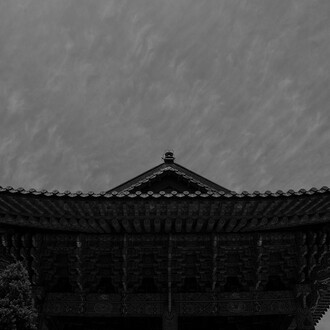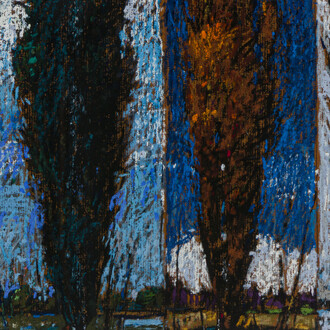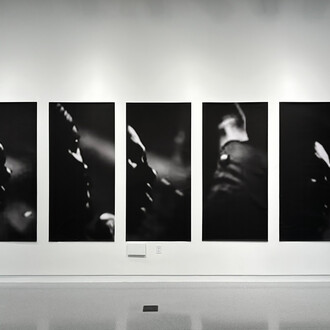Much has been made over the last decade about the increasingly blurring lines between fine art and design, as function and creative innovation meld to produce compelling new kinds of objects. In this context, artist Sven Lukin’s painting-sculptures of the 1960s feel utterly at home and enticingly contemporary. Inspired by the work and vision of acclaimed architect Louis Kahn, Lukin’s enigmatic works are all volumetric forms, geometric fields of color, and illusionistic lines and perspectives. On June 6, Hollis Taggart will open an exhibition focused on Lukin’s work from the ‘60s, highlighting the ongoing interest and appeal of the Post-War artist’s practice. Titled Sven Lukin: Objects in Space, the exhibition will remain on view through July 12, 2019 at the gallery’s primary Chelsea location at 521 West 26th Street.
Lukin was born in Riga, Latvia in 1934, and emigrated to the United States in 1949. He entered the University of Pennsylvania, School of Architecture in 1953, where he was exposed to the teachings of influential architect Louis Kahn. Kahn’s ideas about monumental scale, weight and volume, and the significance of the unadorned surface had a profound effect on Lukin, inspiring his work throughout his life. In 1958, Lukin moved to New York to pursue his art, and in 1961, received a solo exhibition at the famed Betty Parsons Gallery, launching him into the city’s inner art circles.
From the outset of his career, Lukin pushed against the confines of the rectangular canvas. In works like Dances AA (1963), this effort manifests through the strategic use of color, line, and perspective, giving the illusion that the multi-colored geometric form on the surface plane is extending into the space of the viewer. In other cases, as with Untitled (1962-3), Lukin’s engagement with space is physical, as an internal support beneath the stretched canvas actively protrudes forward beyond its frame. Setting this protrusion against two flattened geometric forms, painted in deep blue and burnt orange, Lukin amplifies the tension between the realms of painting and sculpture.
Although Lukin’s name is not as readily recognizable as that of Frank Stella, history has credited Lukin with being among the first artists to experiment with the shaped canvas, exploring the formal and aesthetic opportunities it yielded. While Stella’s interests in the shaped canvas arose from an ongoing exploration of complex geometries, Lukin’s examination of the format remained grounded in ideas related to architecture and urban planning. As physical structures guide the way that we engage with the environment, so too Lukin developed his painting-sculptures to entice the viewer to move forward, away, and to the side in order to understand the real and illusionistic components of the works.
The playful interplay that characterizes Lukin’s work is well encapsulated in Honeymoon (1964), which combines the artist’s beneath-canvas protrusions—rendered here at the top right within a painted blue circle—with a small rectangular canvas that is set into and extends above the picture plane to the left. These components are further juxtaposed with a thick red line that meanders through a bubblegum pink field in the lower register of the work, before dipping into a rich blue stripe at bottom. The work emanates an inner joy as it suggests at once the visual vocabulary of hard-edged abstraction, modernist sculpture, and a futuristic urban plan, while eschewing any simple classification or understanding.
Lukin’s brilliant imagination, consistent experimentation, and penchant for risk-taking made him a rising art world star through the 1960s and into the 1970s. After solo presentations at Betty Parsons and Martha Jackson galleries, Lukin joined Pace Gallery in 1963, which went on to organize five solo shows of the artist’s work. At the same time, Lukin was featured prominently in a series of important museum exhibitions, including The Quest and the Quarry (1961, Rome-New Art Foundation), Annual Exhibition, (1962, 1966, 1967, 1969, Whitney Museum of American Art), The Shaped Canvas (1965, Solomon R. Guggenheim Museum), Color, Image, and Form (1967, Detroit Institute of Arts), and L'art vivant aux États-Unis (1970, Fondation Maeght), among others. In 1972, Lukin severed his ties with Pace Gallery and determined not to show his work in commercial galleries. Although he continued to exhibit, including in a solo exhibition at the Los Angeles County Museum of Art in 1978, his aversion to the commercial artworld hindered his notoriety and the widespread understanding of his practice.
In rediscovering Lukin’s work, we gain an exciting new chapter in the narratives of Post-War American art, expanding our knowledge of the range of voices and innovations that made it such a fertile era for making. As compellingly, though, we find an artist whose work stands the test of time and speaks eloquently to the ongoing contemporary bending of art and design boundaries. Lukin’s exquisite, sometimes whimsical, use of simple forms and volumes along with bold, bright colors to create unclassifiable works comfortably positions him with the realms of today’s object-makers, whose work is shown at such major presentations as Salone de Mobile, Milano and ICFF, opening in New York in May. This seems particularly fitting for an artist whose practice was inspired by architecture and whose work is recognized for its complex engagement with form, material, space, and illusion.
















